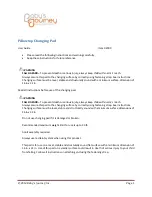
Controller / User Interface | 4-9
Determining temperature
I
f you take the displayed cell temperature and divide it by the T/C Ratio in memo
-
ry location 88, you will have the actual furnace set point control temperature.
You can use a Type-K table to measure the voltage on terminals C and D on
the sensor board, and add the appropriate amount of mVs for the board ambi-
ent. The corresponding temperature from a Type-K thermocouple should be the
actual furnace set point temperature = 695°C / T/C Ratio (memory location 88).
Use the Type-K table to determine the mV change you have for 273°C and add
this mV change for the actual board temperature. This should be the compensa-
tion voltage measured between D+ and 6- on the sensor board. So for a 50°C
ambient at the board, the voltage should be 11.05 mV (273°C) + 2.02 mV (50°C)
= 13.07 mVs.
If you have a T/C ratio of 0.9, the corresponding furnace temperature set point
should be (695°C / 0.9 = 772°C). If you measure the voltage at terminals C and D
on the sensor board with a 50°C ambient, the voltage should be 32.125 (772°C)
- 2.02 mV (50°C) = 30.1 mV. If you add in the compensation voltage for 50°C, the
voltage at terminals 5 and 6 should be 30.1 mV + 12.05 mV = 42.15 mVs which
should also be the voltage that you measures at T/C+ and T/C - terminals on the
Series 2000 wiring card terminals and also the displayed T/C mV value that you
can set one of the display lines to view in the Setup key - Display menu.
T/C Ratio Adjustment Limits for Primary Calibration
Cell Temp °C
Max T/C Ratio
Min T/C Ratio
615
1.3
0.7
650
1.24
0.74
695
1.22
0.777
824
1.139
0.861
790
same as 824°C
Table 4-2.
For a cell operating temperature of 695°C, the T/C ratio low limit is .777 and the
high limit is 1.222, which corresponds to a thermocouple indicated temperature
range of 540°C to 848°C.
•
If you find that a regular calibration isn’t working correctly, first check that
your calibration gas values match the values written on the gas cylinders;
also be sure that the correct flow of gases has been set and that the gases
are allotted enough time to flow through the sensor. Only if these checks
have been done and the system still can’t be properly calibrated should you
perform a primary calibration.
Содержание Thermox WDG Insitu
Страница 12: ...xii Thermox Series 2000 WDG Insitu This page intentionally left blank...
Страница 20: ...1 8 Thermox Series 2000 WDG Insitu Analyzer This page intentionally left blank...
Страница 24: ...2 4 Thermox Series 2000 WDG Insitu Analyzer This page intentionally left blank...
Страница 28: ...3 4 Thermox Series 2000 WDG Insitu Analyzer Figure 3 2 Insitu senor mounting...
Страница 44: ...3 20 Thermox Series 2000 WDG Insitu Analyzer Figure 3 19 Sensor connections...
Страница 51: ...Installation and Start Up 3 27 Figure 3 23 Series 2000 2 Wire RS 485 communications connections...
Страница 53: ...Installation and Start Up 3 29 Figure 3 24 Series 2000 4 wire RS 485 communication connections...
Страница 114: ...6 16 Thermox Series 2000 WDG Insitu Analyzer This page intentionally left blank...
Страница 128: ...7 14 Thermox Series 2000 WDG Insitu Analyzer This page intentionally left blank...
Страница 154: ...A 26 Thermox Series 2000 WDG Insitu Analyzer This page intentionally left blank...
Страница 158: ...B 4 Thermox Series 2000 WDG Insitu Analyzer This page intentionally left blank...
Страница 164: ...D 2 Thermox Series 2000 WDG Insitu Analyzer This page intentionally left blank...
















































